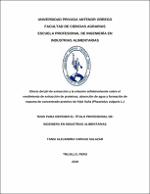Mostrar el registro sencillo del ítem
Efecto del ph de extracción y la relación sólido/solvente sobre el rendimiento de extracción de proteínas, absorción de agua y formación de espuma de concentrado proteico de frijol ñuña (phaseolus vulgaris L.)
| dc.contributor.advisor | Rodriguez Zevallos, Antonio | |
| dc.contributor.author | Vargas Salazar, Tania Alejandra | |
| dc.creator | Vargas Salazar, Tania Alejandra | |
| dc.date.accessioned | 2019-09-16T13:58:48Z | |
| dc.date.available | 2019-09-16T13:58:48Z | |
| dc.date.issued | 2019 | |
| dc.identifier.uri | https://hdl.handle.net/20.500.12759/5415 | |
| dc.description.abstract | En la presente investigación se evaluó el efecto del pH de extracción y la relación sólido/solvente sobre el rendimiento de extracción de proteínas, absorción de agua y formación de espuma de concentrado proteico de frijol ñuña (Phaseolus vulgaris L.), aprovechando así el elevado contenido proteico de la leguminosa como fuente potencial de ingrediente para la industria alimenticia. Se aplicó la metodología de diseño de superficie de respuesta central compuesto rotacional para obtener el mayor rendimiento y capacidad de absorción de agua en concentrado proteico de frijol de ñuña, siendo el modelo cuadrático significativo (p<0.05) y los coeficientes de determinación R 2 y R 2 -ajustado fueron 0.959 y 0.910 para el concentrado proteico y 0.976 y 0.956 para la absorción de agua, sin embargo la formación de espuma el modelo cuadrático no fue significativo (p>0.05), además, los valores de los coeficientes de determinación R 2 y R 2 -ajustado fueron 0.138 y 0.00. El mejor tratamiento para rendimiento de extracción (79.29%) y absorción de agua (3.65 g/g), se obtuvieron con pH de 10.91 y la relación sólido/ solvente de 1/10, cuyo contenido de proteínas fue 81.92%. | es_PE |
| dc.description.abstract | In the present investigation the effect of extraction pH and the solid/solvent ratio on the yield of protein extraction, water absorption and foaming of protein concentrate of ñuña bean (Phaseolus vulgaris L.) was evaluated, taking advantage of the the protein content of the legume as a potential source of ingredient for the food industry. The rotational composite response surface design methodology was applied to obtain the highest yield and water absorption capacity in Ñuña bean protein concentrate, being the quadratic model significant (p <0.05) and the coefficients of determination R2 and R2 -adjusted were 0.959 and 0.910 for the protein concentrate and 0.976 and 0.956 for the absorption of water, however the foam formation of the quadratic model was not significant (p> 0.05), in addition, the values of the coefficients of determination R2 and R2 -adjusted were 0.138 and 0.00. The best treatment for extraction performance (79.29%) and water absorption (3.65 g / g), were obtained with pH of 10.91 and the solid / solvent ratio of 1/10, whose protein content was 81.92%. | en_US |
| dc.description.uri | Tesis | es_PE |
| dc.format | application/pdf | es_PE |
| dc.language.iso | spa | es_PE |
| dc.publisher | Universidad Privada Antenor Orrego | es_PE |
| dc.relation.ispartofseries | T_ALIM_386 | |
| dc.rights | info:eu-repo/semantics/openAccess | es_PE |
| dc.rights.uri | https://creativecommons.org/licenses/by/4.0/ | es_PE |
| dc.source | Universidad Privada Antenor Orrego | es_PE |
| dc.source | Repositorio Institucional - UPAO | es_PE |
| dc.subject | Solido/solvente | es_PE |
| dc.subject | Frijol Ñuña | es_PE |
| dc.title | Efecto del ph de extracción y la relación sólido/solvente sobre el rendimiento de extracción de proteínas, absorción de agua y formación de espuma de concentrado proteico de frijol ñuña (phaseolus vulgaris L.) | es_PE |
| dc.type | info:eu-repo/semantics/bachelorThesis | es_PE |
| thesis.degree.level | Título Profesional | es_PE |
| thesis.degree.grantor | Universidad Privada Antenor Orrego. Facultad de Ciencias Agrarias | es_PE |
| thesis.degree.name | Ingeniero en Industrias Alimentarias | es_PE |
| thesis.degree.discipline | Ingeniería en Industrias Alimentarias | es_PE |
| dc.publisher.country | PE | es_PE |
Ficheros en el ítem
Este ítem aparece en la(s) siguiente(s) colección(es)
-
Industrias Alimentarias [153]


